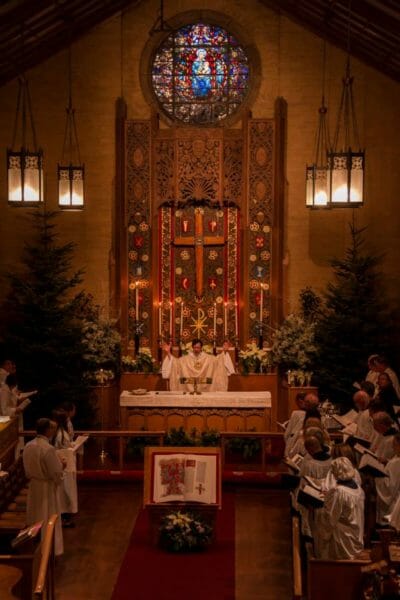Connected Through Time: Epiphany Seattle Acquires the Heritage Edition Years After Hosting
A four-year gap only sharpened the parish’s desire to see The Saint John’s Bible return
As an Episcopal congregation, Epiphany Parish in Seattle observes two foundational liturgical practices: the Liturgy of the Word and the Liturgy of the Table. The former includes reading scripture, prayer, and sermons. The latter creates a more tangible space in which to experience the divine: “It’s mysterious,” according to The Rev. Doyt Conn. “It touches your soul in a way that honors what God’s done in the world.”

Chief among the elements of the Liturgy of the Table – at least, in Conn’s view – is the physicality of participation. Consuming the Eucharist, kneeling for prayer – “There’s this kinetic aspect to it,” he said. That energy, that involvement is part of what attracted the parish to host The Saint John’s Bible in 2013.
Conn said, “It occurred to me when I first encountered this big Bible, this huge book with vibrant colors, that it illustrates the word in a way that’s moving but that also moves you to a different way of experiencing it. You come to know the same words in a different way.” In essence, the Bible itself becomes a physical manifestation of our responsibility to “wrestle” with the Word of God.
A Chance Meeting with the Architect of The Saint John’s Bible
Conn’s own perception of the Heritage Edition deepened when, during a visit to a parishioner’s house in Wales during Epiphany’s Year with The Saint John’s Bible, he met lead artist and calligrapher Donald Jackson at his scriptorium-turned-home nearby. “God created us all with purpose and intent to be in the world for providential opportunity,” Conn said. “[Jackson] truly did step into his calling. He was changed by the experience – his relationship with scripture and even with God changed as he did this.”
The stories of how the artists of The Saint John’s Bible came together to create such a monumental work only added to the presence and provenance of both liturgies practiced at Epiphany Seattle. “I thought it adequately represented the power and the mystery of the Liturgy of the Word in a way that is gripping and in equal measure to what we have in the Liturgy of the Table. I thought, ‘Ah, this balances it out.’”
For Conn and Epiphany, that “balance” does more than create a symbolic corollary between the two guiding liturgies of the Episcopal church. It helps further a vision of connecting the present with the future – and the future with the past.
Communicating Across Generations Using Sacred Symbols

“My son, who’s 14, doesn’t use paper,” Conn said. “We’re moving towards a world where things like books as you and I know them do not exist.” It’s true that technology is driving physical media quickly into obsolescence. To hear Conn say it, though, it’s not so much an obstacle as it is an opportunity – one Epiphany capitalized on by hosting the Heritage Edition.
“Having this great big book planted in the middle of a liturgical light is a connecting thing. It connects us to the age of books – to the beginning of the age of books, where people hand-wrote the Bible. The love of God and the power of the holy scripture and the movement of the person of Jesus through time transcends all of that – and yet, through these ancient mediums, we’re connected through time.”
So connected, in fact, that as soon as Epiphany’s Year with The Saint John’s Bible ended in 2014, Conn felt certain the volumes would return sometime in the future – even though no plan to fund them existed – going so far as to include a drawered display case in the parish’s 2016 renovations. “I just figured it would come back,” he said.

Conn’s faith was rewarded when, after the funeral of a longtime member of the Epiphany community, a fellow church-goer in attendance offered to buy the Heritage Edition outright for use at the parish. She expressed a desire to remember the impact the deceased had on other parishioners – to “mark it in time” – by purchasing the Heritage Edition.
Since its dedication in January 2018, the Heritage Edition has become part of scripture readings, Christian education, children’s courses, and the centerpiece of several speaker and artist presentations at the parish – all years after the set was considered out of reach for Epiphany.
“Churches are funny places,” Conn said. “Sometimes, you just have to be patient.” For the congregation, the interim was nearly as impactful as the year Epiphany spent studying The Saint John’s Bible. “It’s not like the conversation died out,” Conn said. “People knew we had it, knew it was valuable in our system and the manner in which we worship God. You just have to set the intention… and wait.
“I didn’t let go of those conversations. I just let them continue to wash into the reality of the life of the parish. Over time, something washes up on shore.”


